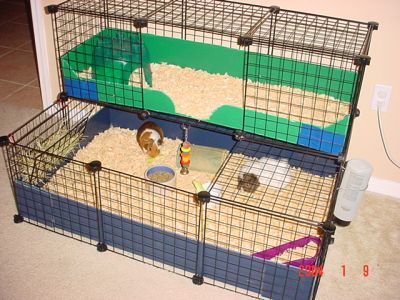When you're looking for a home for your piggie to live in, the two main things to think about are space and ventilation. Guinea pigs are active animals that thrive with a large cage to run around in, preferably 7 square feet or more. They don't do well in damp conditions, so plenty of air flow is a must. Listed below are several popular types of housing and their pros and cons.
Pet store cages - Pet store cages are very popular among new piggie owners. The main problem with these cages is the size. Most of them are completely inappropriate, barely twice as long as a full grown piggie, giving them no room to run around, popcorn, and be a guinea pig! Marchiorio makes some more reasonably-sized ones. They're very easy to clean, and many of them have a second level for the piggies to climb up and sit on. These tend to be expensive though, so you have to be prepared to spend a good bit of money if you want to use this kind of cage.
Tanks - Some people keep piggies in tanks with a screen top. We run into the same problem here as we did with the pet store cages: space. Also tanks don't give good ventilation. Even if you were to find one that was big enough for a piggie, it would be too tall to let enough air in. I have yet to see a tank I would be comfortable housing my pigs in.
C&C Cages - C&C cages, made out of storage cubes/grids and corrugated plastic (some common names for this are correx [UK] and coroplast [US]) are by far the best kind of cage I have ever seen. They are completely customizable, so you can create the best size for you and your piggies. You can make them with a top or without, you can even make separators and second levels. The cube grids snap together with little plastic connectors, or for extra flexibility you can also use cable ties. The plastic (which can be bought at most sign stores) can be cut and folded to make trys for the cage. You can visit the official Cube Cage site with all the details on making your cage here.
 |
Free Range - This is a great way to house piggies if you can possibly manage it: give them a room, a shed, or maybe even your house and let them free range. Of course there are some potential dangers with letting cavies free-range your home, so you'll need to do some piggie-proofing. Keep all electrical wires out of reach of the piggies as they will try to nibble them and can electrocute themselves. Don't put houseplants where piggies can reach them as they may be poisonous. Nibbling on furniture isn't a problem for most piggies, but if you're worried about it keep them away from the furniture too as some paints and finishes are harmful to piggies. Cubes are great for penning off off-limits areas.
Some pigs will use just one corner to go potty in, some will go in several. Just find out where your piggie likes to "go" and put a litter box there. Some piggies will go into an open cage to do their business so you may want to try this too. A few pigs can never be potty trained so you'll have to pen off an area for them where you won't be upset if there are accidents. Even the most well behaved piggie will occasionally drop a bean where they're not supposed to, but these are very neatly packaged and easily swept up.